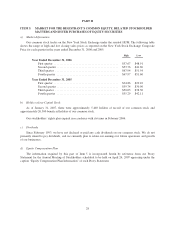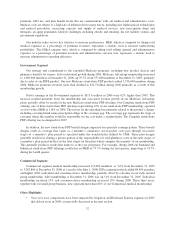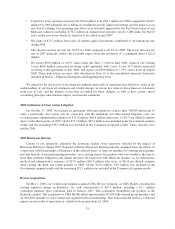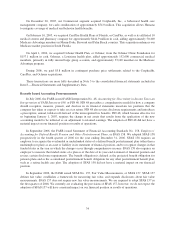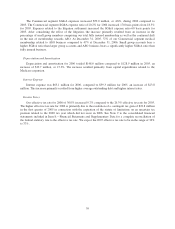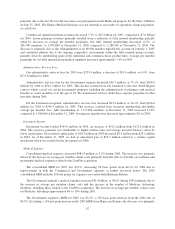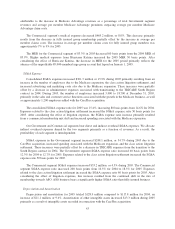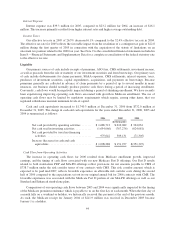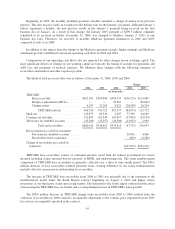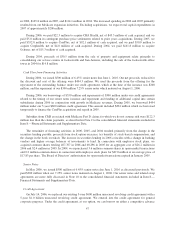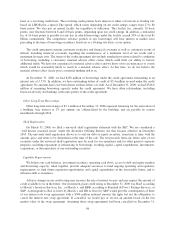Humana 2006 Annual Report Download - page 50
Download and view the complete annual report
Please find page 50 of the 2006 Humana annual report below. You can navigate through the pages in the report by either clicking on the pages listed below, or by using the keyword search tool below to find specific information within the annual report.The Government segment’s medical expenses increased $6.2 billion, or 98.1%, during 2006 compared to
2005. The increase was primarily due to an increase in the number of Medicare members, including those
enrolled in our stand-alone PDPs.
The Government segment’s MER for 2006 was 85.0%, a 190 basis point increase from 2005 of 83.1%. The
increase was primarily attributable to the introduction of the stand-alone PDPs in January 2006 with an MER of
92.5% for 2006. The stand-alone PDP MER was negatively impacted by an MER in our Complete plan of
115.9% for 2006, one of three stand-alone PDP offerings representing approximately 12% of our stand-alone
PDP members. We expect MER to improve in 2007 to approximately 82% to 84% for our combined Medicare
Advantage and stand-alone PDP offerings.
The Commercial segment’s medical expenses decreased $382.3 million, or 7.1%, from 2005 to 2006. This
decrease primarily results from the decrease in fully insured group membership partially offset by the increase in
average per member claims costs. The increase in average per member claims costs for fully insured group
members was approximately 6% for 2006 and is expected to range from 5% to 6% for 2007.
The MER for the Commercial segment of 81.7% in 2006 decreased 160 basis points from 2005 MER of
83.3%. Higher medical expenses from Hurricane Katrina increased the 2005 MER 30 basis points. The decrease
in MER primarily reflects improving medical cost utilization trends and an increase in the percentage of
individual and small group members comprising our total fully insured block. Individual and smaller group
accounts generally carry a lower MER than larger group accounts.
SG&A Expense
Consolidated SG&A expenses increased $825.9 million, or 37.6%, during 2006 compared to 2005. The
increase primarily resulted from an increase in the number of employees and increased sales and marketing costs
due to the Medicare expansion offset by prior year litigation expenses which did not recur in 2006. The number
of employees increased by 3,600 to 22,300 from 18,700 at December 31, 2005, primarily in the customer service
and marketing functions associated with the growth in the Medicare business.
The consolidated SG&A expense ratio for 2006 was 14.3%, decreasing 110 basis points from 15.4% for
2005. Expenses related to the litigation settlement increased the SG&A expense ratio 50 basis points for 2005.
After considering the effects of the litigation settlement, the remaining decrease resulted from growth in revenues
from higher average medical membership outpacing the related increase in administrative spending on a
consolidated basis during 2006.
Our Government and Commercial segments bear direct and indirect overhead SG&A expenses. We allocate
indirect overhead expenses shared by the two segments primarily as a function of revenues. As a result, the
profitability of each segment is interdependent.
Government segment SG&A expenses of $1,730.2 million for 2006 increased $766.9 million, or 79.6%,
from 2005. The increase primarily resulted from higher expenses associated with the infrastructure build out of
our expanded Medicare offerings in the latter half of 2005 through the first half of 2006 as well as increased sales
and marketing costs in 2006 also related to the Medicare expansion.
The Government segment SG&A expense ratio decreased 90 basis points from 12.7% for 2005 to 11.8% for
2006. Expenses related to the litigation settlement increased the SG&A expense ratio 50 basis points for 2005.
After considering the effect of the litigation, the decrease from 2005 to 2006 resulted from average membership
and related revenue associated with the Medicare expansion reaching the levels contemplated by the now
complete build-out of infrastructure and support functions which began in the latter half of 2005, providing more
leverage against administrative costs in 2006.
38


